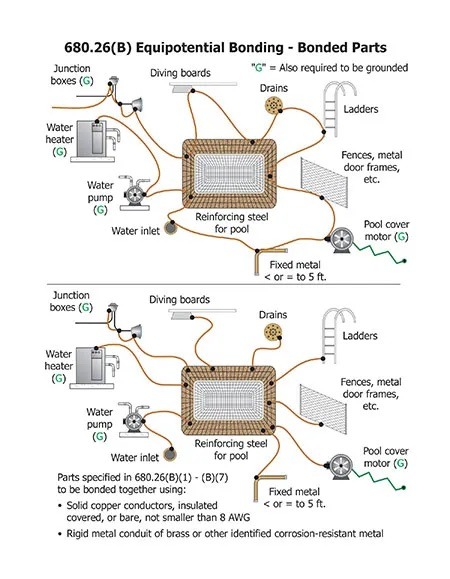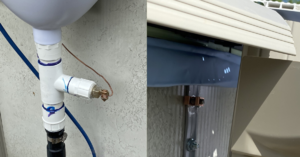| Line 4: | Line 4: | ||
Pool electrical code requirements are described in the National Electric Code (NEC) section 680. The NFPA provides [https://www.nfpa.org/Codes-and-Standards/All-Codes-and-Standards/Free-access free access] to the NEC and other codes. | Pool electrical code requirements are described in the National Electric Code (NEC) section 680. The NFPA provides [https://www.nfpa.org/Codes-and-Standards/All-Codes-and-Standards/Free-access free access] to the NEC and other codes. | ||
| + | |||
| + | [https://www.youtube.com/watch?v=aQ74y46Uzzs 680.26 Equipotential Bonding (swimming pools and similar)] is a good video describing Equipotential Bonding and the 2023 NEC changes. | ||
[https://iaeimagazine.org/magazine/features/systems/taking-the-mystery-out-of-equipotential-bonding-requirements-for-swimming-pools/ Taking the Mystery Out of Equipotential Bonding Requirements for Swimming Pools] is a good primer to understand equipotential bonding in pools. | [https://iaeimagazine.org/magazine/features/systems/taking-the-mystery-out-of-equipotential-bonding-requirements-for-swimming-pools/ Taking the Mystery Out of Equipotential Bonding Requirements for Swimming Pools] is a good primer to understand equipotential bonding in pools. | ||
Revision as of 01:38, 18 April 2024
Technical Details of Bonding a Pool
This wiki is a supplement to the Bonding vs Grounding article in TFP Pool School.
Pool electrical code requirements are described in the National Electric Code (NEC) section 680. The NFPA provides free access to the NEC and other codes.
680.26 Equipotential Bonding (swimming pools and similar) is a good video describing Equipotential Bonding and the 2023 NEC changes.
Taking the Mystery Out of Equipotential Bonding Requirements for Swimming Pools is a good primer to understand equipotential bonding in pools.
A good reference is from Mike Holt Enterprises on Article 680—Swimming Pools, Spas, Hot Tubs, Fountains, and Similar Installations.
Also How to Verify That a Pool is Safe from Electric Shock – In Accordance with the National Electrical Code from Mike Holt.
Pool Bonding 101. Pool Electrical is a good educational video about pool bonding.
National Electric Code (NEC) Versions
Questions often come up asking if an Above Ground Pool needs to be bonded. The NEC does not refer to Above Ground Pools.
The definition of Storable Pools and Permanently Installed Pools have been changing in the NEC.[1]
Previously the NEC said permanently installed swimming, wading, immersion, and therapeutic pools constructed in the ground or partially in the ground, and all others capable of holding water in a depth greater than 42 in., and pools installed inside of a building, regardless of water depth, whether or not served by electrical circuits of any nature must be bonded.
The 2023 update to the NEC changed the definitions to:
- Permanently Installed Swimming, Wading, Immersion and Therapeutic Pools - Those that are constructed or installed in the ground or partially in the ground, and all pools installed inside of a building, whether or not served by electrical circuits or any nature.
- Storable Pool - Pools installed entirely on or above the ground that are intended to be stored when not in use and are designed for ease of relocation, regardless of water depth.
If you are looking to satisfy an Inspector in your Jurisdiction you should confirm what NEC version is currently adopted and being applied. Jurisdictions can take years to change to a more recent NEC version. The NEC is updated every 3 years and the current version is 2023. Prior NEC versions were 2020, 2017, 2014, 2011, etc.
Bonding a Permanently Installed Pool
2023 NEC 680.26 specifies that the following must be bonded:
- For Pool Water Bonding required by NEC Article 680.26(C), concrete pools are considered conductive (refer to 680.26 (b)(1) due to the porosity of concrete and the bonding of rebar. No additional bonding is required. Vinyl liner and fiberglass composite shells are considered non-conductive and require a water bond.
- Perimeter Surfaces for 1 meter (3 feet) horizontally beyond the inside walls of the pool
- All metallic parts of the pool structure
- Underwater lighting except for listed low-voltage lighting systems with non-metallic forming shells
- All metal fittings within or attached to the pool structure
- Electrical equipment including pool water circulation, treatment, heating, cooling, or dehumidifier equipment. Electrically operated pool covers. Any other equipment within 5 feet measured horizontally from the inside wall of the pool unless separated from the pool by a permanent barrier.
- Fixed metal parts within 5 feet horizontally from the inside wall of the pool. That includes metal fences, metal awnings, metal door and window frames, metal piping, metal-sheathed cables and raceways.
- Pool water if none of the bonded parts are in direct connection with the pool water.
Note that 2023 NEC 680.26(B)(6)(b) refers to pool water heaters rated at more than 50 amperes, that some Heat Pumps qualify as, and having specific instructions regarding bonding and grounding, only those parts designated to be bonded shall be bonded and only those parts designated to be grounded shall be grounded. Thus the 2023 NEC implies that Heat Pumps rated to 50 amperes or less must be bonded meeting 680.26(B)(6).
Bonding an Above Ground Pool
The 2023 NEC version specifies no bonding requirements in 680 Part III - Storable Pools.
Bonding requirements for above ground pools in prior NEC versions have included:
- The bonding conductor must be 8 AWG bare solid copper[2]. Now the bonding wire can be 8 gauge or larger and insulated, covered, or bare.
- You can not use sheet metal screws or rivits to connect the bonding conductor. Use stainless machine screws.
- The bonding conductor must be secured in or under the deck or unpaved surface within 4 in. to 6 in. below the subgrade and must be located between 18 in. and 24 in. from the inside walls of the pool.
- All fixed metal parts within 5 feet of the pool must be bonded to the equipotential grid, including but not limited to, "metal-sheathed cables and raceways, metal piping, metal awnings, metal fences, and metal door and window frames."
- Attachments for the bonding wire must be listed for the application.
- The pool water must be bonded to the bonding loop with a device like:
- the Burndy BWB680AGRK Waterbug Pool Water Bonding Kit.[3] You drill a hole through your skimmer and install it there.
- the Perma-Cast PB2008 Water Bonding Fitting PB-2008 in the pipe going to the pump on a tee fitting
- From the loop you will also need to provide a connection that will go to the pump bonding lug, heater bonding lug and any other metal component at the pad.
- Copper lugs and split bolts are used to connect the bonding wires together into one loop.
- at a minimum four (4) points uniformly spaced around the perimeter of the pool connected to the bonding loop is required. On an above ground pool this may require drilling 4 holes equally spaced at 4 points around the pool low enough that they will be below the liner and attach the direct burial rated lugs that way.[4]
- on a pool with a metal wall code requires one bond point. This post explains the logic.
The NEC did make note that not all pool shells/frames can be bonded because they are either plastic or fiberglass. Then make sure your pump and water are bonded and heater if you have one.
Bonding a Fiberglass Pool
The rebar in the collar of a fiberglass pool must be connected to the bonding grid.
A fiberglass pool is non-conductive and requires a water bond.
Troubleshooting a Tingle or Shock
Finding stray voltage sources take a lot of detective work. Here are some threads to give you ideas of what you are looking for:
Here is a thread that has been going on for 6 years trying to find the source of a tingle - A Slight Shock.
Here the voltage source was a streetlight connected to the house power line Bonding Issue In A Pool.
Here the Power Company was called in and found the house neutral was damaged and sending current to ground - ELECTRICITY in the water! What could be causing it - how to stop it?
Bonding Prevents Shocks or Electrocution From Stray Currents
It does happen...
Expert: Breached bonding wire could have led to teen's electrocution
- ↑ https://iaeimagazine.org/electrical-fundamentals/permanent-or-storable-when-it-comes-to-pools-definitions-make-all-the-difference/#:~:text=In%20past%20Code%20cycles%20%28and%20the%20current%202020,to%20only%20to%20a%20depth%20of%2042%20inches.
- ↑ https://www.troublefreepool.com/threads/bonding-above-ground-pool-trying-to-understand.109181/post-959987
- ↑ https://www.troublefreepool.com/threads/18x34-doughboy-autumn-breeze-finished.44544/post-383567
- ↑ https://www.troublefreepool.com/threads/bonding-issues-for-above-ground-pool.119829/post-1060396





